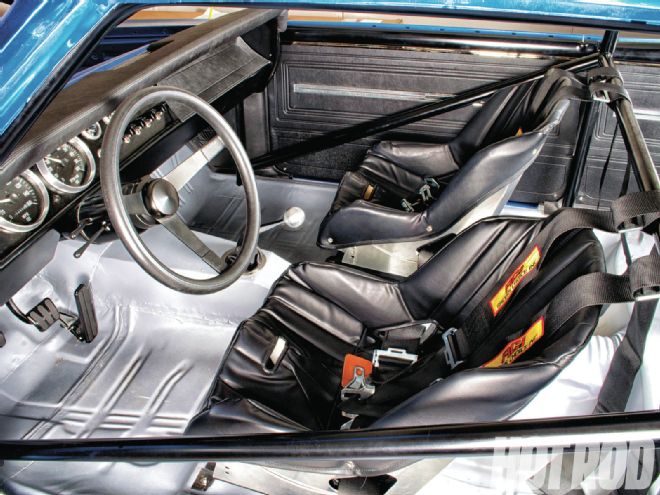
This story is all about form following function. When you build something with a priority on performance, sometimes you overlook the pulchritude. There are no apologies and no explanations needed. That's one of the things that makes rat rods so cool--they aren't trying to pretend to be something they're not. We wondered what would happen if we styled a muscle car interior after a late-'60s SCCA Trans-Am race car. The racing versions of the car still retained the classic lines of the production vehicles from the era, and the interiors were stripped and simplified versions of the original. They were functional, lightweight, and had most of the necessary features in a modern Pro Touring car, with a bend toward performance rather than having creature comforts such as A/C and a radio.
We started with a '66 Chevelle that had seen a variety of use over its 46 years, and the interior was in desperate need of gutting. The entire car was being remade for road racing, auto crossing, and Power Tour® duty, so a race-inspired interior would fit it well. The driving force behind a bare-minumum interior is the desire to shave weight. We weighed every part we removed and installed in the new interior to see how we netted out. If less weight was our only goal, we would have made some sacrifices to style, but we managed to reduce the overall weight of the car by a whopping 239 pounds, even though we added a 10-point rollcage. We also created an interior with loads of style that's easy to replicate. The best part is that the dashboard we chose is the only thing specific to a Chevelle. All the other modifications we show here can be used to put any muscle car on a diet while creating a stylish, retro interior.
Where We Cut the Fat
We weighed every piece of the interior that we removed and every new part that went in. We included the weight of the cage in overall reduction, but did not include the new Eastwood Thermo-Coustic sound deadener or C.A.R.S. Inc. Daytona Weave carpet. This chart shows how even small parts add up to make a difference, and it explains why race cars have gutted interiors.
Item Removed Weight (pounds)Item Replacing It (pounds)Net Weight Reduction Complete original dash assembly (34.4)ABC Performance dash (21.2)13.2 Factory front bucket seats (46.4) x2Kirkey aluminum bucket seats (13.0)66.8 Aftermarket stereo with subwoofer cabinet (125.0)None (0.0)125.0 Carpet set (16.2)None (0.0)16.2 Previous sound deadener (50.0)None (0.0)50.0 Heater box (19.0)None (0.0)19.0 Rear seat (44.8)None (0.0)44.8 ABC Performance 'cage added (-96.0)-96.0 Total Weight Reduction239.0
Man, That's Loud!
For the sake of weight savings, we initially left the floor of the car completely uncovered. The sheetmetal was painted medium gray, which is a race-car trick used to make it easy to spot fatigue cracks. However, after just a few hundred miles of street driving, we decided this made the car much louder and hotter than we wanted to tolerate on a cross-country driver. We covered the floor with Eastwood Thermo-Coustic and found a cool-looking carpet in the C.A.R.S. Inc. inventory. The Thermo-Coustic has a peel-and-stick backing for easy application, and the butyl rubber material reduces vibration for less noise, making the sound much more pleasing. The product also limits the transfer of heat. The Daytona carpet from C.A.R.S. Inc. is a tight weave with a foam back. There's zero pile to it, so it creates a smooth and uniform look.
We measured the noise and temperature before and after and found interesting results. We used a decibel (dB) meter, which measures sound pressure. Generally, anything that makes more than a 2 dB difference is noticeable. We found a measured improvement with both the carpet and Thermo-Coustic. However, the products improved the sound quality much more than what the dB meter indicated. With nothing on the floor except paint, we measured 97 dB at 60 mph in Fifth gear, and the sound was downright irritating. Installing the Eastwood Thermo-Coustic over the floor (not the sides, doors, or roof) lowered the sound level to 94 dB and greatly mellowed the tone. Adding the C.A.R.S. Inc. Daytona Weave further reduced the sound to 91 dB. The interior noise went from creating fatigue after about 15 minutes to being enjoyable.